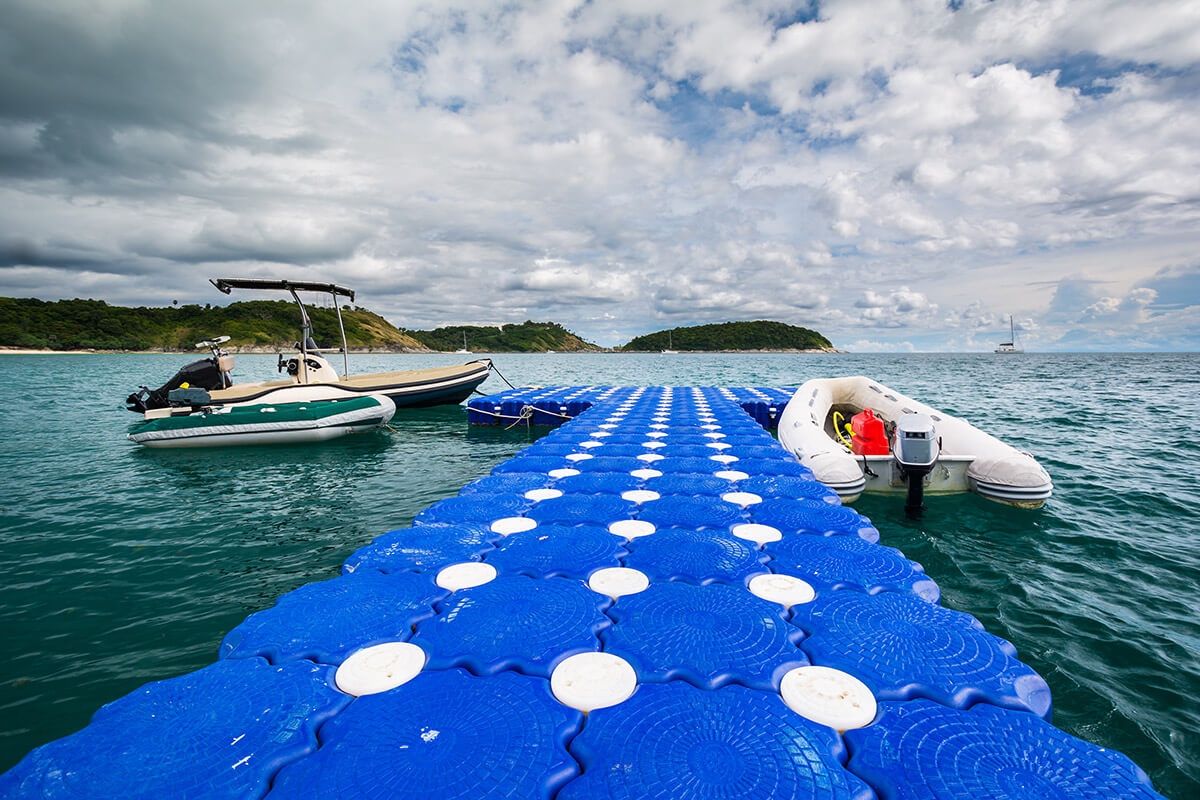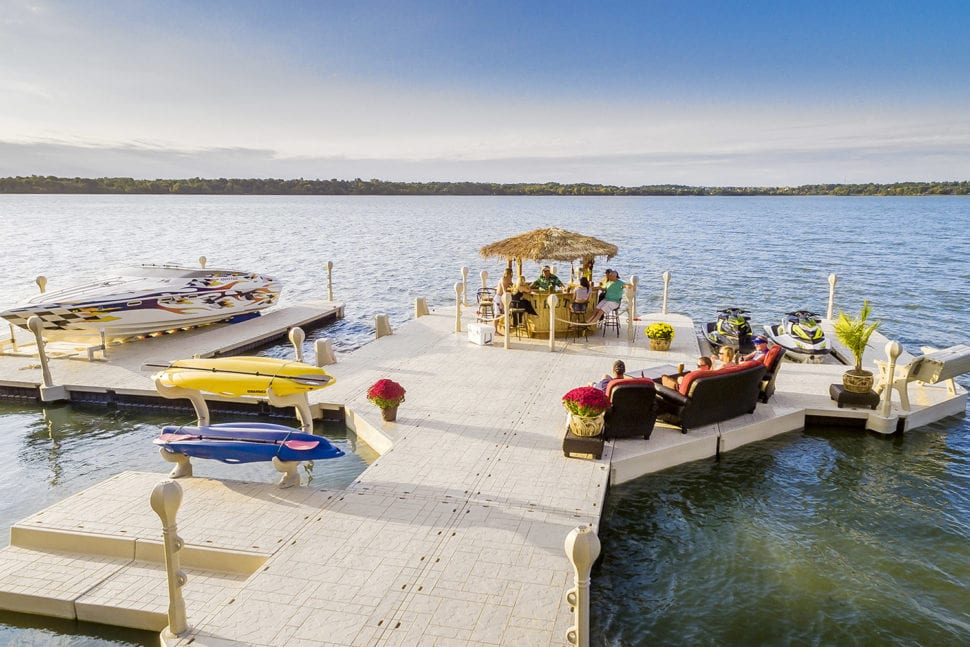Maximizing Your Outdoor Area with Specialized Floating Dock Solutions
Wiki Article
Upgrade Your Waterside With Long Lasting Floating Docks
Upgrading your waterside with sturdy floating docks can considerably improve both functionality and visual appeals, giving a functional remedy for various water tasks. With an array of materials offered, including low-maintenance alternatives and conventional timber, selecting the best dock can complement your individual design and fulfill practical needs.Benefits of Floating Docks
Floating docks deal a multitude of advantages that boost their allure for various maritime applications. One of the key advantages is their flexibility to transforming water levels - floating docks. Unlike conventional fixed docks, floating docks surge and autumn with the tide, making certain regular access for watercrafts and watercraft regardless of ecological problems. This function considerably reduces the danger of damage to vessels, as they continue to be firmly tied even during variations in water depth.
Additionally, floating docks are easier to relocate and mount, offering flexibility for seasonal or short-lived usage. Their modular design permits for customization to fit details requirements, whether for exclusive marinas, property waterfronts, or industrial applications.
Moreover, floating docks create marginal disturbance to the water setting, preserving regional ecosystems and decreasing the chance of disintegration. They additionally provide improved safety and security and security for users, as their buoyant nature provides a more forgiving surface area than inflexible structures.
Additionally, floating docks can promote a varied series of activities, such as fishing, swimming, and recreational boating, making them a beneficial possession for waterside growth. Their flexibility and functionality make floating docks a preferred option for a selection of maritime projects.
Choosing the Right Materials
Selecting suitable materials for floating docks is crucial to their long life, efficiency, and total performance. When picking products, take into consideration variables such as ecological direct exposure, upkeep needs, and architectural honesty. Usual products include wood, plastic, aluminum, and composite options, each offering distinct advantages and drawbacks.Timber, while visually pleasing, needs normal maintenance to avoid rot and decay. Pressure-treated timber can improve durability, however it may still catch water damage gradually. Plastic floats, often made from high-density polyethylene, are immune to deterioration and call for very little maintenance, making them an eye-catching option for low-maintenance applications.
Aluminum is one more sensible alternative, known for its stamina and light-weight residential or commercial properties. It is resistant to rust and can stand up to rough weather, although it may be extra costly than various other products. Composite products combine the best characteristics of wood and plastic, offering a low-maintenance and resilient choice that simulates the appearance of timber without the associated downsides.
Inevitably, the selection of material should line up with the intended usage, environmental considerations, and spending plan restraints, guaranteeing a useful and sturdy floating dock that meets your particular requirements.
Installment Process Summary
The effective installation of a floating dock counts on careful preparation and implementation, making certain that right here it runs successfully in its intended setting. The initial step entails examining site problems, including water deepness, coastline features, and dominating weather patterns, which will notify the dock layout and anchoring system.Adhering to the website evaluation, the next phase is to prepare the floating dock elements. This consists of constructing the frame, safeguarding floats, and affixing any necessary equipment. It is essential to make certain that all connections are water-resistant and durable to endure marine problems.
Once the dock is set up, the installment process commences look at here now with placing the dock in the water. This can involve a crane or other lifting devices, especially for larger frameworks. Correct positioning is crucial for functionality and safety and security.

Maintenance Tips for Durability
Normal maintenance is vital for guaranteeing the longevity and optimum efficiency of a floating dock. To achieve this, start with regular inspections at the very least twice a year, concentrating on the stability of the dock's structure, consisting of the flotation devices and attaching equipment. Try to find indications of wear, damage, or deterioration, and address any type of concerns without delay to avoid additional damage.Cleaning is another important facet of maintenance. Eliminate debris, algae, and barnacles from the dock's surface to stop unsafe conditions and keep aesthetic appeal. Make use of a moderate cleaning agent and a soft brush to stay clear of damaging the dock's materials.
Additionally, make sure that the dock is effectively secured and safeguarded to stand up to seasonal adjustments in water degrees and weather. Check the anchoring system for stability and make modifications as needed.
Enhancing Your Outside Aesthetic
To create a visually enticing outdoor space, incorporating a floating dock can significantly improve the total aesthetic of your waterside home. Floating docks are not just useful yet can additionally act as a striking focal point that enhances the natural environments - floating docks. Readily available in read the full info here numerous products and designs, these docks can be customized to match your building's building design and landscapeThe addition of attractive aspects, such as integrated lighting or stylish railings, further elevates the dock's aesthetic appeal. Consider making use of natural wood surfaces, which blend effortlessly with the setting, or selecting modern products like aluminum or composite outdoor decking that offer a smooth, modern appearance.
Purposefully placing planters or seating areas on or around the dock can create welcoming spaces that urge leisure and enjoyment of beachfront views. Furthermore, integrating colors and textures that integrate with your landscape will certainly develop a cohesive visual throughout your outdoor location.

Conclusion

Upgrading your beachfront with sturdy floating docks can considerably improve both functionality and visual appeals, supplying a versatile option for different water tasks. Unlike typical set docks, floating docks surge and loss with the tide, guaranteeing constant access for watercrafts and boat regardless of ecological conditions.Choosing proper materials for floating docks is important to their durability, efficiency, and total effectiveness.As soon as the dock is put together, the installation process commences with placing the dock in the water.In summary, floating docks deal countless advantages, including flexibility to water degree changes and a variety of material alternatives.
Report this wiki page